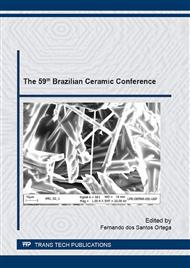p.12
p.18
p.24
p.30
p.35
p.41
p.46
p.52
p.58
Synthesis and Characterization of Co/SBA-15 Catalysts
Abstract:
The mesoporous silica SBA-15 molecular sieve has been widely studied due to its unidirectional mesoporous structure, its high average pore diameter, its high thermal and hydrothermal stability and its ability to absorb metal ions, allowing its use as support material for catalysts. This study aimed to synthesize the Co/SBA-15 catalyst, and characterize it through the techniques of X-ray diffraction, temperature programmed reduction (TPR) and scanning electron microscopy (SEM). The SBA-15 support was synthesized from the following molar composition of reaction mixture: 1TEOS: 0.017 P123: 5.7 HCl: 173 H2O: 40 EtOH, and after calcined at 550 °C for 6 hours. The Co/SBA-15 catalyst was prepared by incorporating 10% cobalt by wet impregnation. Through the X-ray diffractograms, it was found that the impregnation has not changed the structure of the material. RTP profiles showed the presence of peaks at different temperatures that may be caused by dispersion of the cobalt.
Info:
Periodical:
Pages:
35-40
Citation:
Online since:
November 2016
Keywords:
Price:
Сopyright:
© 2017 Trans Tech Publications Ltd. All Rights Reserved
Share:
Citation:


